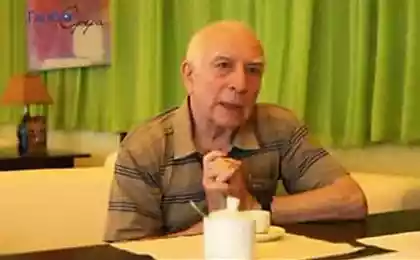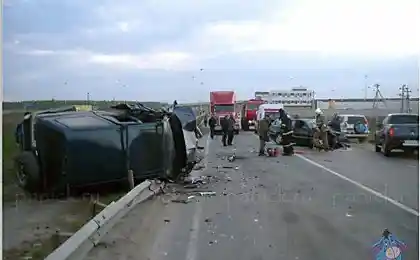956
The world is changing rapidly
Cashless economy
In cash very long history. However, their value dropped significantly after the computer has picked up almost everything in their hands.
Today, you can easily use your smartphone to pay for a particular service or product, or settle in a vending machine.
Against this background, the cash look pretty archaic. The costs of any country in the world to maintain the contents of hard currency and huge, in fact, still forged money.
In the solution to this problem is also leaving a fairly large amount of money.

Criminals and tax evaders enjoy anonymity because of cash. In total, for example, the maintenance of paper currency costs the US economy $ 200 billion annually.
That's more than the United Kingdom spends on health care, which they have developed very well. By the way, the issue of health care, paper money, usually teeming with bacteria.
So there will be soon a society in which there will be no cash? Almost certainly. Sweden might be a pioneer of this business. For example, you can no longer go to the Swedish coach, having only cash.

Of course, the transition to a cashless system costs will not be as smooth. First of all, it comes to privacy, because all your expenses will be tracked.
Human psychology makes us spend more wisely when we are forced to part with physical objects in our purses or wallets. But no matter what, not so long left to the failure of the American and European world of cash, perhaps it will happen in our lifetime with you.
The largest population

The human population has increased steadily over the past 15 000 years, with the past 300 years it has grown by 10 times. According to the experts, we have overcome the 7-billion barrier just a few years ago, it's just 12 years after reaching 6 billion.
Most likely, it may take a little more than 10 years, and we will have 8 billion. Will the population begin to move in the opposite direction? Some studies say that it will not happen in a very distant future.

One Austrian study suggests that there is a 84 percent probability that the population will reach its peak in 2100. Scientists in Spain say that it will happen even earlier - in 2050.
Of course, there is a possibility that we will become more and more. We could cross the barrier and 10 billion by the end of the next century, and then the population may start to decrease. Then we need to learn to live up to 150 years to be a witness to this.
People - centenarians
There will be the first people to live to 150 years

"Seven billionth milestone" has caught the attention of so many people.
The British expert on aging Aubrey de Grey (Aubrey de Gray) believes that the first person who will live to 150 years old, has already been born. It is likely that it was someone from your circle, or you yourself.
You'll have plenty of time to see how humanity reaches certain milestones. Soon people will be able to able to run a marathon in two hours. Haile Gebrselassi (Haile Gebrselassie), one of the greatest long-distance runners, as well as the person who held for many years the world record for the marathon, said that it will happen just in the next generation.
Others believe that it is impossible. Overcoming two kilometers in three minutes soon will become a reality, with no use of performance enhancing drugs and other stimulants.
Apparently, in the next few decades, we will reach the first trillion. A huge milestone will be the emergence of supercomputers ekzaflop instead of today's petaflop. However, we can never come to the following prefixes - zetaflopu, at least with today functioning silicon chips.
Silicon chips
End of life silicon chips

Many of you are probably familiar with Moore's Law, which represents an exponential improvement in computer technology over the last decade. Initially, it was said, the number of transistors that we can accommodate the integrated circuit doubles approximately every two years.
However, today we reach the limit of what might be done with silicon computer systems. Despite the fact that silicon can be said, has created a large number of jobs for a long period of time, it will soon require a more expensive computer systems in order to move forward in terms of technology.

Giant computer and computing, IBM is looking for a solution in carbon nanotubes, and researchers at Stanford have created a trial scheme for the demonstration of the technology. Nanotubes are smaller, lighter and will manifest themselves in comparison with silicon, so they can increase processing power.
Quantum computing gone forward even more and will in the near future to determine the fate of computer equipment.
The revolutionary 4D Printing

Many say that the future for 3D printing, which has an amazing potential. But we can go even further, literally using printing technology 4D, which will create objects that collect themselves.
Printing to create industrial goods production has a number of advantages. On the one hand, you do not have to puzzle over from Ikea instruction how to assemble their own furniture. Programmed materials - those materials which can change its shape or behavior depending on conditions such as, for example, temperature.
You just print the object, and then be able to change a part of creating a more complex creation.
Furniture, building vehicles that could meet on their own, would have been particularly useful in space exploration. Engineers are already working on spacecraft, which are themselves going in orbit to create a huge solar panels capable of providing a huge amount of energy.
But 4D printing come into its own is actually a much smaller scale. Creation of nanomaterials requires a lot of energy and effort by using traditional methods.
Self-organization - is the most promising route for the mass production of nanostructures. A team of chemists from the University of Sheffield in the UK are currently working on the creation of a tiny robot that can "self-assembled" inside the human body and kill all the cancer cells there.
A new way to fight bacteria

The need for new medical developments is becoming more apparent, because we see that the current available methods, we are beginning to fail. Antibiotics, which are likely to have saved you or someone you know is, are gradually fading into oblivion, because the bacteria are becoming increasingly resistant to them, and we need new tools to fight.
One possibility - fighting bacterial infections by viral infection, i.e. by bacteria viral infections. The viruses that attack bacteria, known as bacteriophages, moreover they force their owners to literally fall apart.
Scientists do not even have to use the virus as a whole. For example, a team of Israeli experts have recently identified a protein of bacteriophage, which will help to create drugs that destroy the bacteria inside.
Another possible way - is the introduction of chemicals that will link existing antibodies against infectious agents causing active immune system. This technology was developed by microbiologist Carey Mullis (Kary Mullis), winner of the Nobel Prize.
DAPRA, known for that is at the forefront of the creation of military equipment, putting high stakes on nanotechnology. Its experts intend to develop nanoparticles that can hit the bacteria and using chemicals to reprogram their genes.
Thus, once the bacteria will develop the technology you can correct as soon as possible to solve the problem.
Other groups of scientists are working to develop antibiotics that are different from those that exist today. For example, they will attack the cell membrane of a disease.

The team from Taiwan is in the process of creating particles that will attack a specific group of bacteria, heat them and kill germs exposed to laser light.
Meanwhile, experts are also working on the prevention of infections to reduce the need for antibiotics. Scientists in Singapore have created a positively charged "cells", which is a coating that attracts to itself negatively charged bacteria in this way that they rupture and die.
Experts plan to transform "cell" in the drug that can fight diseases such as meningitis and pneumonia.
Extinction of species
Apocalypse mammals

A quarter of the world's mammal species (there are about 4000) in the coming 30 years are threatened with extinction.
And they talk about it very seriously. After some 25 years, we can live in a world in which no more elephants, rhinos and lions. Gorillas are also on the verge of extinction due to hunting them for their meat, habitat destruction (deforestation) and mining.
This is not to mention the Siberian tiger, and a 51 bats, which have long been in a sinister list for extinction.

After a few generations of half the animals that adorned the books of our childhood, sink into oblivion. In fact, scientists believe that we are currently going through a period of mass extinction. There is about the same as what happened in the age of dinosaurs.
This extinction is likely to be the sixth in a row on this scale in the history of the Earth. And to a large extent the fault lies with the people.
Gasoline in the world
Last petrol

In the battle for the future of the war between electric vehicles and automobiles with internal combustion engines has a long history. Until 1900, electric cars were the dominant player in the market, they made less unpleasant odors, they were quieter and much easier to operate compared to its other fuel.
Today, returning to electric vehicles is already underway for the full program. Do you agree or disagree with the fact that global warming is anthropogenic origin (about 97 percent of climate scientists say), but the oil is actually finite, and soon we can stay without it.
We need more renewable power our cars. Therefore, it does not have to wait so long to complete the transition to electric cars.
Shell's oil experts say that the last petrol car off the assembly line not earlier than 2070.
The potential change of the players can only speed up the process. We have so many clean, reliable and safe electricity that oil is simply no chance.
Stationary phone with a tube
Death landlines

You have a phone? More quarter century ago, the responses to this question was a little "push" or "disk." Of course, countless lives have been saved by using these phones.
In this regard, the governments of developed countries are forced telecommunication companies to maintain the network infrastructure if they are to stay in business. It costs companies billions, and, experts say, it withdraws funds that could go to the transition to the new alternatives.
Fixed telephony systems today are increasingly more active and losing popularity. Many people living in rural areas, probably more for a long time will enjoy the phone because it is for certain - this is the only way to communicate.
Moreover, a fixed phone has one important advantage: during a power failure the phone is still working.
Incurable disease

The victory over the invincible diseases
HIV and AIDS is just one generation of people has become one of the most common diseases in the world. Tens of millions of people live with the disease, while tens of millions have already died.
However, the situation is changing, and the disease, which has grown together with one generation can be defeated by the next generation.
The number of children infected with HIV each year is falling rapidly, the rate of decline has doubled compared with 2003. Statistical data on deaths are also impressive - only in South Africa from AIDS in 2011 died per 100 000 less than in 2005.
The key stage of this struggle will be the time when will be born healthy children - a generation without AIDS.
The first disease that mankind is likely to win without a vaccine will be guinea worm disease, a terrible parasitic infection, which burns the skin and spread in unclean drinking water. The number of people - carriers of infections decreased from 3, 5 million in 1986 to 542 in 2012.
The World Health Organization hopes to completely get rid of it by 2015. By 2020, WHO plans to get rid of even a single bacterial infection - yaws (the number of cases decreased from 50 million in 1952 to 2, 5 million in 1964).
Yaws does not exist in India, as well as polio, another disease that will completely disappear from the face Ze mli in the coming years.
©
In cash very long history. However, their value dropped significantly after the computer has picked up almost everything in their hands.
Today, you can easily use your smartphone to pay for a particular service or product, or settle in a vending machine.
Against this background, the cash look pretty archaic. The costs of any country in the world to maintain the contents of hard currency and huge, in fact, still forged money.
In the solution to this problem is also leaving a fairly large amount of money.

Criminals and tax evaders enjoy anonymity because of cash. In total, for example, the maintenance of paper currency costs the US economy $ 200 billion annually.
That's more than the United Kingdom spends on health care, which they have developed very well. By the way, the issue of health care, paper money, usually teeming with bacteria.
So there will be soon a society in which there will be no cash? Almost certainly. Sweden might be a pioneer of this business. For example, you can no longer go to the Swedish coach, having only cash.

Of course, the transition to a cashless system costs will not be as smooth. First of all, it comes to privacy, because all your expenses will be tracked.
Human psychology makes us spend more wisely when we are forced to part with physical objects in our purses or wallets. But no matter what, not so long left to the failure of the American and European world of cash, perhaps it will happen in our lifetime with you.
The largest population

The human population has increased steadily over the past 15 000 years, with the past 300 years it has grown by 10 times. According to the experts, we have overcome the 7-billion barrier just a few years ago, it's just 12 years after reaching 6 billion.
Most likely, it may take a little more than 10 years, and we will have 8 billion. Will the population begin to move in the opposite direction? Some studies say that it will not happen in a very distant future.

One Austrian study suggests that there is a 84 percent probability that the population will reach its peak in 2100. Scientists in Spain say that it will happen even earlier - in 2050.
Of course, there is a possibility that we will become more and more. We could cross the barrier and 10 billion by the end of the next century, and then the population may start to decrease. Then we need to learn to live up to 150 years to be a witness to this.
People - centenarians
There will be the first people to live to 150 years

"Seven billionth milestone" has caught the attention of so many people.
The British expert on aging Aubrey de Grey (Aubrey de Gray) believes that the first person who will live to 150 years old, has already been born. It is likely that it was someone from your circle, or you yourself.
You'll have plenty of time to see how humanity reaches certain milestones. Soon people will be able to able to run a marathon in two hours. Haile Gebrselassi (Haile Gebrselassie), one of the greatest long-distance runners, as well as the person who held for many years the world record for the marathon, said that it will happen just in the next generation.
Others believe that it is impossible. Overcoming two kilometers in three minutes soon will become a reality, with no use of performance enhancing drugs and other stimulants.
Apparently, in the next few decades, we will reach the first trillion. A huge milestone will be the emergence of supercomputers ekzaflop instead of today's petaflop. However, we can never come to the following prefixes - zetaflopu, at least with today functioning silicon chips.
Silicon chips
End of life silicon chips

Many of you are probably familiar with Moore's Law, which represents an exponential improvement in computer technology over the last decade. Initially, it was said, the number of transistors that we can accommodate the integrated circuit doubles approximately every two years.
However, today we reach the limit of what might be done with silicon computer systems. Despite the fact that silicon can be said, has created a large number of jobs for a long period of time, it will soon require a more expensive computer systems in order to move forward in terms of technology.

Giant computer and computing, IBM is looking for a solution in carbon nanotubes, and researchers at Stanford have created a trial scheme for the demonstration of the technology. Nanotubes are smaller, lighter and will manifest themselves in comparison with silicon, so they can increase processing power.
Quantum computing gone forward even more and will in the near future to determine the fate of computer equipment.
The revolutionary 4D Printing

Many say that the future for 3D printing, which has an amazing potential. But we can go even further, literally using printing technology 4D, which will create objects that collect themselves.
Printing to create industrial goods production has a number of advantages. On the one hand, you do not have to puzzle over from Ikea instruction how to assemble their own furniture. Programmed materials - those materials which can change its shape or behavior depending on conditions such as, for example, temperature.
You just print the object, and then be able to change a part of creating a more complex creation.
Furniture, building vehicles that could meet on their own, would have been particularly useful in space exploration. Engineers are already working on spacecraft, which are themselves going in orbit to create a huge solar panels capable of providing a huge amount of energy.
But 4D printing come into its own is actually a much smaller scale. Creation of nanomaterials requires a lot of energy and effort by using traditional methods.
Self-organization - is the most promising route for the mass production of nanostructures. A team of chemists from the University of Sheffield in the UK are currently working on the creation of a tiny robot that can "self-assembled" inside the human body and kill all the cancer cells there.
A new way to fight bacteria

The need for new medical developments is becoming more apparent, because we see that the current available methods, we are beginning to fail. Antibiotics, which are likely to have saved you or someone you know is, are gradually fading into oblivion, because the bacteria are becoming increasingly resistant to them, and we need new tools to fight.
One possibility - fighting bacterial infections by viral infection, i.e. by bacteria viral infections. The viruses that attack bacteria, known as bacteriophages, moreover they force their owners to literally fall apart.
Scientists do not even have to use the virus as a whole. For example, a team of Israeli experts have recently identified a protein of bacteriophage, which will help to create drugs that destroy the bacteria inside.
Another possible way - is the introduction of chemicals that will link existing antibodies against infectious agents causing active immune system. This technology was developed by microbiologist Carey Mullis (Kary Mullis), winner of the Nobel Prize.
DAPRA, known for that is at the forefront of the creation of military equipment, putting high stakes on nanotechnology. Its experts intend to develop nanoparticles that can hit the bacteria and using chemicals to reprogram their genes.
Thus, once the bacteria will develop the technology you can correct as soon as possible to solve the problem.
Other groups of scientists are working to develop antibiotics that are different from those that exist today. For example, they will attack the cell membrane of a disease.

The team from Taiwan is in the process of creating particles that will attack a specific group of bacteria, heat them and kill germs exposed to laser light.
Meanwhile, experts are also working on the prevention of infections to reduce the need for antibiotics. Scientists in Singapore have created a positively charged "cells", which is a coating that attracts to itself negatively charged bacteria in this way that they rupture and die.
Experts plan to transform "cell" in the drug that can fight diseases such as meningitis and pneumonia.
Extinction of species
Apocalypse mammals

A quarter of the world's mammal species (there are about 4000) in the coming 30 years are threatened with extinction.
And they talk about it very seriously. After some 25 years, we can live in a world in which no more elephants, rhinos and lions. Gorillas are also on the verge of extinction due to hunting them for their meat, habitat destruction (deforestation) and mining.
This is not to mention the Siberian tiger, and a 51 bats, which have long been in a sinister list for extinction.

After a few generations of half the animals that adorned the books of our childhood, sink into oblivion. In fact, scientists believe that we are currently going through a period of mass extinction. There is about the same as what happened in the age of dinosaurs.
This extinction is likely to be the sixth in a row on this scale in the history of the Earth. And to a large extent the fault lies with the people.
Gasoline in the world
Last petrol

In the battle for the future of the war between electric vehicles and automobiles with internal combustion engines has a long history. Until 1900, electric cars were the dominant player in the market, they made less unpleasant odors, they were quieter and much easier to operate compared to its other fuel.
Today, returning to electric vehicles is already underway for the full program. Do you agree or disagree with the fact that global warming is anthropogenic origin (about 97 percent of climate scientists say), but the oil is actually finite, and soon we can stay without it.
We need more renewable power our cars. Therefore, it does not have to wait so long to complete the transition to electric cars.
Shell's oil experts say that the last petrol car off the assembly line not earlier than 2070.
The potential change of the players can only speed up the process. We have so many clean, reliable and safe electricity that oil is simply no chance.
Stationary phone with a tube
Death landlines

You have a phone? More quarter century ago, the responses to this question was a little "push" or "disk." Of course, countless lives have been saved by using these phones.
In this regard, the governments of developed countries are forced telecommunication companies to maintain the network infrastructure if they are to stay in business. It costs companies billions, and, experts say, it withdraws funds that could go to the transition to the new alternatives.
Fixed telephony systems today are increasingly more active and losing popularity. Many people living in rural areas, probably more for a long time will enjoy the phone because it is for certain - this is the only way to communicate.
Moreover, a fixed phone has one important advantage: during a power failure the phone is still working.
Incurable disease

The victory over the invincible diseases
HIV and AIDS is just one generation of people has become one of the most common diseases in the world. Tens of millions of people live with the disease, while tens of millions have already died.
However, the situation is changing, and the disease, which has grown together with one generation can be defeated by the next generation.
The number of children infected with HIV each year is falling rapidly, the rate of decline has doubled compared with 2003. Statistical data on deaths are also impressive - only in South Africa from AIDS in 2011 died per 100 000 less than in 2005.
The key stage of this struggle will be the time when will be born healthy children - a generation without AIDS.
The first disease that mankind is likely to win without a vaccine will be guinea worm disease, a terrible parasitic infection, which burns the skin and spread in unclean drinking water. The number of people - carriers of infections decreased from 3, 5 million in 1986 to 542 in 2012.
The World Health Organization hopes to completely get rid of it by 2015. By 2020, WHO plans to get rid of even a single bacterial infection - yaws (the number of cases decreased from 50 million in 1952 to 2, 5 million in 1964).
Yaws does not exist in India, as well as polio, another disease that will completely disappear from the face Ze mli in the coming years.
©
























